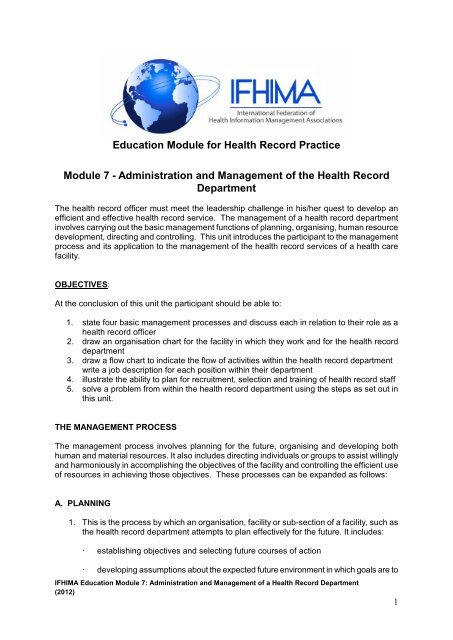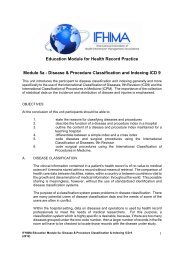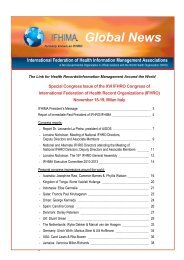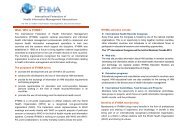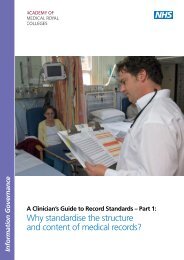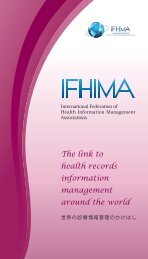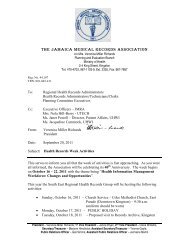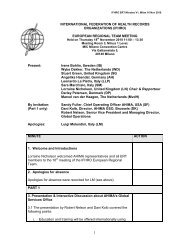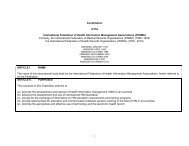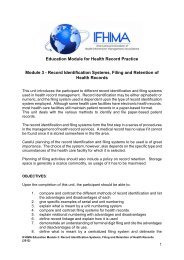Education Module for Health Record Practice Module 7 ... - ifhima
Education Module for Health Record Practice Module 7 ... - ifhima
Education Module for Health Record Practice Module 7 ... - ifhima
Create successful ePaper yourself
Turn your PDF publications into a flip-book with our unique Google optimized e-Paper software.
<strong>Education</strong> <strong>Module</strong> <strong>for</strong> <strong>Health</strong> <strong>Record</strong> <strong>Practice</strong><br />
<strong>Module</strong> 7 - Administration and Management of the <strong>Health</strong> <strong>Record</strong><br />
Department<br />
The health record officer must meet the leadership challenge in his/her quest to develop an<br />
efficient and effective health record service. The management of a health record department<br />
involves carrying out the basic management functions of planning, organising, human resource<br />
development, directing and controlling. This unit introduces the participant to the management<br />
process and its application to the management of the health record services of a health care<br />
facility.<br />
OBJECTIVES:<br />
At the conclusion of this unit the participant should be able to:<br />
1. state four basic management processes and discuss each in relation to their role as a<br />
health record officer<br />
2. draw an organisation chart <strong>for</strong> the facility in which they work and <strong>for</strong> the health record<br />
department<br />
3. draw a flow chart to indicate the flow of activities within the health record department<br />
write a job description <strong>for</strong> each position within their department<br />
4. illustrate the ability to plan <strong>for</strong> recruitment, selection and training of health record staff<br />
5. solve a problem from within the health record department using the steps as set out in<br />
this unit.<br />
THE MANAGEMENT PROCESS<br />
The management process involves planning <strong>for</strong> the future, organising and developing both<br />
human and material resources. It also includes directing individuals or groups to assist willingly<br />
and harmoniously in accomplishing the objectives of the facility and controlling the efficient use<br />
of resources in achieving those objectives. These processes can be expanded as follows:<br />
A. PLANNING<br />
1. This is the process by which an organisation, facility or sub-section of a facility, such as<br />
the health record department attempts to plan effectively <strong>for</strong> the future. It includes:<br />
· establishing objectives and selecting future courses of action<br />
· developing assumptions about the expected future environment in which goals are to<br />
IFHIMA <strong>Education</strong> <strong>Module</strong> 7: Administration and Management of a <strong>Health</strong> <strong>Record</strong> Department<br />
(2012)<br />
1
e met <strong>for</strong> instance, a manual or automated environment<br />
· identifying and selecting alternate courses of action which are available to meet the<br />
set objectives<br />
· initiating activities within the department which will be necessary to translate plans<br />
into action, and<br />
· critically reviewing and evaluating the outcome. That is, were the planned objectives<br />
achieved, if not, why?<br />
2. The planning process <strong>for</strong> all health record officers there<strong>for</strong>e would be to:<br />
· set ACHIEVABLE objectives relative to the perceived requirements of the<br />
department<br />
· examine the present environment and <strong>for</strong>ecast changes that are likely to influence<br />
the department in accomplishing the objectives. With the ever increasing<br />
developments in technology, health record officers must be alert at all times to<br />
technological advances, particularly to computer applications in health care<br />
· identify alternative courses of action, evaluate these alternatives in light of previous<br />
assumptions made, and then select the course of action, which, after careful<br />
deliberations, appears to be the one which will best suit the department's<br />
requirements. This is part of the decision-making process in management<br />
· implement the plans with check points to indicate progress during implementation<br />
· evaluate the implemented plans with regard to effectiveness, efficiency and<br />
achievement of the departments objectives (Huffman, 1990).<br />
Planning at all levels provides direction and a sense of purpose. It helps health record<br />
officers cope with change and contributes to the per<strong>for</strong>mance of other management<br />
functions.<br />
Planning the physical layout of the health record department is discussed in Unit 8.<br />
B. ORGANISING<br />
This is the process by which employees in the health record department and the jobs they do<br />
are related to each other. It consists of dividing work among groups and individuals and<br />
providing the co-ordination required between individuals and group activities (Bedeian &<br />
Glueck, 1983). This is often referred to as the division of labour.<br />
Organising also involves the establishment and recognition of managerial authority.<br />
Individual work tasks must be organised into distinct jobs. This is part of what is normally<br />
referred to as job design.<br />
1. Job design, job analysis and work satisfaction<br />
JOB DESIGN involves specifying job content, work methods used <strong>for</strong> the job and the<br />
relationship between and among individual jobs within the department.<br />
IFHIMA <strong>Education</strong> <strong>Module</strong> 7: Administration and Management of a <strong>Health</strong> <strong>Record</strong> Department<br />
(2012)<br />
2
Each job should be assembled into work units within the department. In turn, the<br />
combination of work units within the department must be logically combined to <strong>for</strong>m an<br />
overall organisational framework. And finally, the design of individual jobs and work units<br />
within the department, as well as the overall framework of the facility must be related to<br />
the environmental influences within the community.<br />
Once jobs have been defined, further in<strong>for</strong>mation relating to the proposed content of<br />
each job should be collected. This process is called a JOB ANALYSIS and will help the<br />
MRO determine the skills, knowledge and abilities required to do the job and at the same<br />
time clarify lines of responsibility and authority. When working through this process, it is<br />
important to remember that job content will alter with various changes in technology and<br />
the MRO must predict, wherever possible, <strong>for</strong> future changes.<br />
This identification of the work to be per<strong>for</strong>med in each job provides an extremely<br />
important basis <strong>for</strong> planning personnel requirements. Because of its importance with<br />
regard to recruiting and selection, a job analysis should describe not only content, but<br />
also specifications.<br />
If the MRO is involved in planning a health record department <strong>for</strong> a new hospital he or<br />
she will rely heavily on their skills and knowledge of health record management which will<br />
enable them to design the anticipated jobs and conduct a job analysis. If the department<br />
is being redesigned in an existing hospital, the MRO will need to analyse existing jobs<br />
within the old department and predict future changes. The tools used in the second case<br />
could be a combination of observation and an interview with each staff member.<br />
When organising the work within a health record department the following should be kept<br />
in mind.<br />
a) Job description and specification<br />
Job analysis will provide two types of in<strong>for</strong>mation (i) a JOB DESCRIPTION and (ii) a<br />
JOB SPECIFICATION. Job descriptions actually describe the characteristics of a<br />
job. A sample job description is illustrated in Appendix 3. Job specification will<br />
indicate the skills required <strong>for</strong> each job, e.g. typing and transcription.<br />
IFHIMA <strong>Education</strong> <strong>Module</strong> 7: Administration and Management of a <strong>Health</strong> <strong>Record</strong> Department<br />
(2012)<br />
3
) Improving work satisfaction<br />
How to induce employees to per<strong>for</strong>m work that is boring and unsatisfying is a matter<br />
of concern to employers. The subject of work satisfaction is an extremely<br />
complicated one that defies any simplistic explanation or solution. There are many<br />
variables that help to determine whether or not work in a particular job will prove<br />
satisfying to a particular employee per<strong>for</strong>ming it (Charns & Schaefer, 1983). These<br />
variables include:<br />
i) Variables relating to the work of an employee<br />
Variables considered to have an effect upon the satisfaction to be derived from a<br />
job include:<br />
· variety (tools, equipment, activities and workplace)<br />
· autonomy (independence and control in per<strong>for</strong>ming job)<br />
· interaction (number and types of inter-relationships)<br />
· knowledge and skill (time required <strong>for</strong> proficiency)<br />
· responsibility (closeness of supervision and cost of mistakes)<br />
· task identity (how one's contributions add to the total ef<strong>for</strong>t)<br />
· feedback (being kept in<strong>for</strong>med)<br />
· pay (wages and fringe benefits)<br />
· working conditions (physical work environment)<br />
· cycle time (time required to per<strong>for</strong>m a unit of work)<br />
ii)<br />
Individual differences among employees<br />
A major difficulty in determining how to increase job satisfaction stems from the<br />
individual differences among employees. Differences in abilities, backgrounds,<br />
and social conditioning affect the specific psychological need patterns of<br />
employees and the specific returns that each may seek from work. As a result of<br />
these differences, work that is boring, repetitious and unchallenging to one<br />
individual may be satisfying to another. Methods used to increase satisfaction,<br />
there<strong>for</strong>e, must take into account not only the structure and working conditions of<br />
jobs, but also the needs of specific individuals.<br />
IFHIMA <strong>Education</strong> <strong>Module</strong> 7: Administration and Management of a <strong>Health</strong> <strong>Record</strong> Department<br />
(2012)<br />
4
iii) Differences in abilities<br />
Employees who have the ability to per<strong>for</strong>m their jobs well are more likely to gain<br />
satisfaction from their work. Jobs, however, must provide employees with the<br />
opportunity to utilise their abilities to the fullest extent. Otherwise, under-utilisation<br />
can be a source of dissatisfaction.<br />
iv) Differences in attitudes and personnel adjustment<br />
Employees who are well adjusted emotionally are more likely to be satisfied with<br />
their job situations than those who are not. Furthermore, if dissatisfaction stems<br />
from causes within the individual it is not likely to be reduced significantly by<br />
changing the job design or work environment. Neither are these individuals likely<br />
to resolve their internal problems by moving from one employment situation to<br />
another.<br />
v) Differences in perceptions of equity<br />
It is essential that the various financial and psychological rewards employees<br />
receive from their work be equitable both in terms of what is demanded of them<br />
and in terms of what others are receiving <strong>for</strong> their work. Even more important,<br />
these rewards must be perceived by the employees as being equitable.<br />
Otherwise, the satisfaction and benefits that might be derived from effective job<br />
design and employee-job matching may be reduced substantially.<br />
vi) Differences in occupational prestige<br />
Employees may derive satisfaction from the prestige of their occupation and/or<br />
reputation of the organisation in which they work. It is a source of satisfaction <strong>for</strong><br />
employees to have friends and acquaintances know that they are part of a<br />
prestigious organisation and making a contribution to it, even if only in a very<br />
small way. In fact one study indicated that occupational prestige contributes more<br />
to job satisfaction than does work autonomy, authority or income.<br />
vii)<br />
Satisfaction through job enrichment<br />
JOB ENRICHMENT essentially is an extension of JOB ENLARGEMENT (i.e. Job<br />
Enlargement - giving employees a greater variety of duties to per<strong>for</strong>m) which may<br />
involve increasing autonomy and responsibility of employees, or including them<br />
to a greater extent in the decision-making process. It provides employees with<br />
the opportunity to make greater use of their knowledge and skill by becoming<br />
more involved in planning, directing and controlling the work of their jobs. Job<br />
enrichment may include delegating to a work group greater authority <strong>for</strong><br />
self-management. It also may include improving communications to the extent<br />
that employees are made more aware of the fact that good per<strong>for</strong>mance will be<br />
recognised and will contribute toward the attainment of both personal and<br />
organisational goals. The basic contribution of job enrichment, there<strong>for</strong>e, is to<br />
make their work more meaningful and to provide employees with a greater sense<br />
of responsibility and the better knowledge of the results of their endeavours.<br />
IFHIMA <strong>Education</strong> <strong>Module</strong> 7: Administration and Management of a <strong>Health</strong> <strong>Record</strong> Department<br />
(2012)<br />
5
2. Formalising organisational structure<br />
ORGANISATION CHARTS are the most common method used to <strong>for</strong>malise the structure<br />
of an organisation.<br />
a) Organisation chart<br />
An organisation chart is merely a graphic representation or blue print of all positions<br />
in a facility and departments of that facility and how they are connected. The position<br />
with the greatest authority is located at the top. Solid lines are used to show line<br />
relationships, that is, those positions that have a direct responsibility in<br />
accomplishing the objectives of the organization, and indicate to whom each position<br />
reports thus clarifying the position's authority and responsibility. Dotted lines are<br />
used to show staff relationships, that is, those positions that are of an advisory<br />
nature.<br />
No organisation chart can totally reflect the facility's structure. The INFORMAL<br />
relationships between employees are generally omitted.<br />
The organization chart should be updated every time there is a change in reporting<br />
relationships. It is there<strong>for</strong>e important to to date the organisation chart.<br />
A Flow Chart of the work in the health record department should also be prepared,<br />
and kept updated, to identify any problem areas. Examples of organisation and<br />
department charts are attached in Appendix 2.<br />
b) Organisational manuals<br />
The departmental manager must set goals and objectives and provide scope and<br />
direction <strong>for</strong> his/her staff. He must be a good leader, a good listener and a good<br />
planner. The department must have a clear set of policies and written procedures.<br />
Policies provide guidelines <strong>for</strong> decision making; they define the area in which<br />
decisions are made but do not provide the manager with the decision. Thus, the<br />
policies aid the manager in the decision making process.<br />
c) Procedures<br />
A procedure is a series of related steps designed to accomplish a specific task. The<br />
health record officer is responsible <strong>for</strong> planning the department's procedures and<br />
providing <strong>for</strong> a standardisation of work tasks within the health record department.<br />
Each procedure must be carefully planned to help with productivity and reduce time<br />
and ef<strong>for</strong>t.<br />
When establishing procedures the following points should be considered:<br />
· determine all the steps required <strong>for</strong> a procedure and use only the minimum<br />
needed to carry out the procedure<br />
· determine the best sequence <strong>for</strong> the per<strong>for</strong>mance of each step in the<br />
procedure<br />
· review procedures which might be affected by changes in other procedures<br />
· test a procedure be<strong>for</strong>e putting it into everyday use<br />
IFHIMA <strong>Education</strong> <strong>Module</strong> 7: Administration and Management of a <strong>Health</strong> <strong>Record</strong> Department<br />
(2012)<br />
6
· evaluate the procedure after it has been used <strong>for</strong> several weeks.<br />
All procedures should be written and updated regularly to eliminate redundancy.<br />
3. Organisational change and development<br />
Change is an integral part of the work of any organisation and health record officers<br />
must be prepared <strong>for</strong> change within the facility and within the functioning of their own<br />
department. They must learn to deal positively with resistance to change. This would<br />
require the following:<br />
· continued in-service education programmes <strong>for</strong> staff<br />
· open lines of communication between staff and the health record officer<br />
· participation and involvement of staff in planned change<br />
· facilitations and support of staff during and after a planned change<br />
· negotiation and agreement with staff relating to changed work conditions and<br />
other issues<br />
· co-operative work per<strong>for</strong>mance both from management and staff<br />
· feedback to staff on effective changes and appreciation of work undertaken by<br />
staff in the implementation of the change.<br />
4. Developing human resources<br />
Staffing and human resource management is the process of assuring that competent<br />
workers are selected, trained and rewarded <strong>for</strong> their assistance in helping the facility<br />
and department achieve their objectives. Being effective in this area also includes<br />
providing a work climate in which employees can experience satisfaction and<br />
development.<br />
IFHIMA <strong>Education</strong> <strong>Module</strong> 7: Administration and Management of a <strong>Health</strong> <strong>Record</strong> Department<br />
(2012)<br />
7
C. DIRECTING<br />
Developing human resources, there<strong>for</strong>e, includes:<br />
· employment planning<br />
· advertising <strong>for</strong> new staff<br />
· recruiting quality applicants<br />
· selecting the best person <strong>for</strong> the job<br />
· orientating the new staff member to the facility and the department<br />
· training and developing new employees<br />
· appraising work per<strong>for</strong>mance on a regular basis (at least once a year)<br />
· compensating the competent worker with the right remuneration.<br />
Directing, also referred to as leadership, and interpersonal influence is the process of<br />
inducing individuals (peers, superiors, sub-ordinates) or groups to assist WILLINGLY<br />
and HARMONIOUSLY in accomplishing the objectives of the facility and the department.<br />
D. CONTROLLING<br />
This is the process of ensuring the efficient use of resources and achieving the<br />
objectives of the facility. It involves:<br />
· establishing standards of per<strong>for</strong>mance of staff and self<br />
· comparing current per<strong>for</strong>mance against established standards to determine the<br />
departments progress toward the set objectives<br />
· actively working to rein<strong>for</strong>ce a high quality of services by the department and<br />
correcting any shortcomings or problems as they occur.<br />
E. PROBLEM SOLVING<br />
This is an extremely important function of a manager, particularly within a very busy<br />
health record department.<br />
1. Problems must be dealt with efficiently and effectively and should NOT be handled<br />
lightly or ignored.<br />
2. Steps in the problem solving process include (Gilbertson & Stone, 1985):<br />
· defining the problems - WHAT IS WRONG?<br />
· identifying causes and underlying relationships of the problem. That is, WHAT<br />
CAUSED THE PROBLEM?<br />
· ANALYSING the evidence relating to the cause of the problem. This can<br />
become quite detailed and difficult<br />
IFHIMA <strong>Education</strong> <strong>Module</strong> 7: Administration and Management of a <strong>Health</strong> <strong>Record</strong> Department<br />
(2012)<br />
8
· developing alternative courses of action and identifying consequences of the<br />
action. That is, WHAT CAN BE DONE TO SOLVE THE PROBLEM? You may<br />
come up with a number of alternatives.<br />
· selecting the 'best' alternative and developing defined steps to implement the<br />
selected alternative<br />
· evaluating the outcome of the implemented solution. That is, HAS IT BEEN<br />
EFFECTIVE - IS THE PROBLEM RESOLVED?<br />
SUMMARY:<br />
Management is a complex issue. We would all like to be considered a good manager. If you<br />
remember the basic management principles outlined in this unit and supplement your knowledge<br />
by further reading you will develop good managerial skills. Remember, however, no one is<br />
perfect and no matter how hard we try we all make mistakes at some time. We are often not as<br />
effective or efficient as we would wish to be. We are, however, capable of learning from our<br />
mistakes and by continually learning, become more effective and efficient in our jobs.<br />
To be a good manager, there<strong>for</strong>, the health record officer should set objectives <strong>for</strong> the services<br />
of his department and continually work towards:<br />
· improving work per<strong>for</strong>mance of staff<br />
· improving work satisfaction<br />
· planning <strong>for</strong> change and implementing change<br />
· improving the layout of the department<br />
· organising effective and efficient work flow<br />
· setting standards of work per<strong>for</strong>mance <strong>for</strong> staff<br />
· directing the services of the department to see that health records are readily available<br />
<strong>for</strong> patient care at all times<br />
This unit briefly covers some important areas of management and as discussed at the beginning<br />
of these learning packages the material presented is not definitive. There is still a lot to learn<br />
and we strongly advise that you continue to do so by reading, listening and participating in as<br />
many educational activities as possible.<br />
IFHIMA <strong>Education</strong> <strong>Module</strong> 7: Administration and Management of a <strong>Health</strong> <strong>Record</strong> Department<br />
(2012)<br />
9
REVIEW QUESTIONS:<br />
1. Why is planning and organising so important <strong>for</strong> a health record officer?<br />
2. Draw an organisation chart of a health facility and of a health record department.<br />
3. Draw a flow chart to indicate the flow of activities in a health record department.<br />
4. Write a job description <strong>for</strong> your position.<br />
5. Identify a problem and work through the steps of problem solving.<br />
REFERENCES:<br />
1. Bedeian, A.G. & Glueck, W.F. (1983). Management (3rd ed). Chicago: The Dryden Press.<br />
2. Charns, M.P. & Schaefer, M.J. (1983). <strong>Health</strong> Care Organizations: A Model <strong>for</strong> Management.<br />
New Jersey: Prentice-Hall.<br />
3. Gilbertson, D.W. & Stone, R.J. (1985). Human Resource Management (2nd ed). Sydney:<br />
McGraw-Hill Book Company.<br />
4. Huffman, E. (1994). <strong>Health</strong> In<strong>for</strong>mation Management (10th ed). Berwyn, Illinois: Physicians'<br />
<strong>Record</strong> Company.<br />
Copyright © 2012 by the International Federation of <strong>Health</strong> In<strong>for</strong>mation Management Associations.<br />
The compilation of in<strong>for</strong>mation contained in these modules is the property of IFHIMA, which reserves all rights<br />
thereto, including copyrights. Neither the modules nor any parts thereof may be altered, republished, resold, or<br />
duplicated, <strong>for</strong> commercial or any other purposes<br />
IFHIMA <strong>Education</strong> <strong>Module</strong> 7: Administration and Management of a <strong>Health</strong> <strong>Record</strong> Department<br />
(2012)<br />
10


